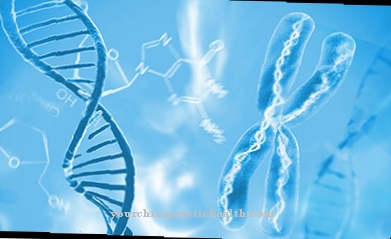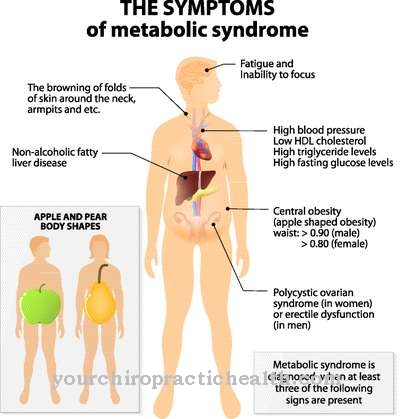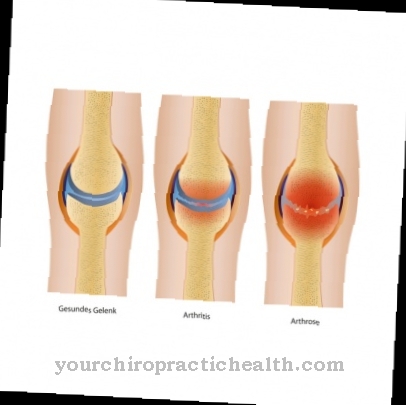In the Amelogenesis imperfecta it is a genetic dental disease. Congenital enamel hypoplasia leads to the fact that enamel formation is impaired. The affected teeth have an increased risk of developing caries and are very temperature-sensitive. In principle, any tooth can be affected by amelogenesis imperfecta.
What is amelogenesis imperfecta?

The congenital disruption of tooth enamel formation that occurs in the context of amelogenesis imperfecta is caused by proteins that are malfunctioning. Tooth enamel is mainly composed of minerals, the structure of which is controlled by certain protein components.
The proteins responsible for amelogenesis imperfecta are enamelin, ameloblastin, amelogenin and tuftelin. Teeth affected by the amelogenesis imperfecta have a yellowish to grayish or brownish discoloration. Amelogenesis imperfecta occurs more frequently in people with the so-called Williams-Beuren syndrome.
causes
The main cause of the development of amelogenesis imperfecta is the disruption of enamel formation. The tendency to impaired tooth enamel formation is innate. The disease can be inherited as an autosomal recessive, autosomal dominant or x-linked trait. Depending on the location of the amelogenesis imperfecta, different forms of the disease result.
In addition, observations show that amelogenesis imperfecta occurs increasingly with various disorders of the teeth, for example in combination with eruption disorders of teeth, the formation of hard substance on the edge of the pulp of the tooth, crown and root resorptions or an insufficient number of teeth.
You can find your medication here
➔ Medicines against tartar and tooth discolorationSymptoms, ailments & signs
In principle, both milk teeth and permanent teeth can be affected by amelogenesis imperfecta. The disease can manifest itself in a number of different symptoms. For example, the teeth can show visual changes, such as a rough and matt surface or yellowish to brownish discoloration.
The enamel surface can shine and tend to split quickly. The thickness of the enamel is often reduced at certain points or over an area. In addition, the teeth affected by amelogenesis imperfecta are mostly hypersensitive and especially very sensitive to high and low temperatures. Missing contact points with neighboring teeth and very soft tooth enamel can appear.
In addition, amelogenesis imperfecta can lead to various impairments of the gums, for example in the form of inflammation of the gums (gingivitis) or gum growths (gingival hyperplasia). Other possible symptoms are a frontal open bite and loss of bite height. In general, an amelogenesis imperfecta can be associated with pain in the corresponding teeth for the affected patient.
Diagnosis & course
When diagnosing amelogenesis imperfecta, it must be taken into account that there are numerous different manifestations of the disease. For this reason, a thorough medical history is particularly important. On the one hand, it can be used to determine whether the amelogenesis imperfecta was caused by a hereditary component.
On the other hand, the differentiation from other diseases of the teeth with similar symptoms is particularly relevant in order to be able to initiate an adequate treatment. An X-ray examination can be used to determine whether the density of the tooth enamel has been reduced. In the context of differential diagnostics, it is important to rule out other diseases.
These include acquired enamel disorders or dentinogenesis imperfecta, which is an autosomal dominant inherited structural disorder of the tooth dentition (teeth eruption from the jaw). Enamel dysplasias, which may be associated with other diseases, must also be ruled out. Symptoms similar to amelogenesis imperfecta are also found in Turner's teeth or in dental fluorosis.
Complications
Amelogenesis imperfecta is a congenital defect that destroys tooth enamel. It is a seldom occurring condition and has a variety of appearances. The detailed anamnesis helps to avoid serious complications. Even with the milk teeth there is massive abrasion and tooth loss.
Food intake is becoming increasingly difficult, painful inflammation and fever make the child suffer and language acquisition can only be poorly developed. The teeth begin to splinter, react hypersensitively to temperature differences and the symptom is often accompanied by growths on the gums and gingivitis.
Differential diagnostics ensure the diagnosis and early therapeutic interventions are initiated. This method is particularly important for small children so that the teeth can develop properly. The same applies to adults who are affected by tooth loss. In addition to the loss of firmness and bite height, the aesthetic aspect comes into play here.
The enamel density is measured on the basis of the X-ray examination. Depending on the advanced stage, the teeth, in children even the milk teeth, are provided with strip or steel crowns or fillings made of plastic, all-ceramic or zirconium dioxide. This will keep them as long as possible. Amelogenesis imperfecta can put the patient in front of great psychological and physical resilience, but complications can be avoided if they are found in good time.
When should you go to the doctor?
Amelogenesis imperfecta in most cases leads to increased caries formation on the teeth. In most cases, the life of the person affected is not particularly restricted by this disease if good oral hygiene is observed. However, regular check-ups and treatment at the dentist are necessary so that there is no permanent damage to the teeth.
As a rule, a doctor should be consulted if the amelogenesis imperfecta leads to caries attack on the teeth. A dentist has to be visited. Of course, the dentist should also be contacted for any other oral complaints in order to treat them. There is no spontaneous healing. Tooth decay is revealed by pain in the affected teeth at the latest. This can be removed relatively easily and uncomplicated, so that the person concerned does not suffer from any further complaints. Parents in particular need to teach their children good oral hygiene to prevent tooth decay from developing.
Doctors & therapists in your area
Treatment & Therapy
As part of an amelogenesis imperfecta, the teeth are usually rubbed off rapidly and rapidly. For this reason, early therapeutic intervention is always useful. Due to the excessive wear and tear of the teeth, the patient's bite height is quickly reduced, which can lead to serious problems, for example when chopping food.
If milk teeth are affected by amelogenesis imperfecta, plastic fillings, steel crowns or strip crowns are often used methods. This allows the milk teeth to be preserved until they naturally fall out, which enables the child to eat regularly. Maintaining the milk teeth is also of great relevance for undisturbed language development.
For amelogenesis imperfecta in adulthood, in addition to plastic fillings, various types of crowns, such as all-ceramic or zirconium dioxide, can be used. Therapy should be started in good time in order to contain serious damage. In this way, the restrictions can also be eliminated at an early stage. The teeth affected by the amelogenesis imperfecta can be largely aesthetically and functionally rehabilitated.
This is particularly important in view of the fact that amelogenesis imperfecta in many cases also represents a psychological burden for the affected patient. The soft enamel, which turns yellow or brown in color and wears off quickly, not only causes local complaints, but also affects the visual appearance of the person. This is especially true if the affected teeth are in the front of the dentition.
Outlook & forecast
As a rule, amelogenesis imperfecta increases the risk of developing caries. The affected person's teeth are therefore often sensitive to pain and temperature, which can lead to discomfort or pain when taking food or liquids. This also significantly reduces the patient's quality of life and, in the worst case, can lead to tooth loss.
In addition, those affected often suffer from inflammation of the tooth roots due to amelogenesis imperfecta. These then have to be removed by a medical intervention. This can also damage the gums and the entire oral cavity. The person concerned is then usually dependent on regular visits to a dentist so that there are no further problems with the teeth.
If the amelogenesis imperfecta leads to caries infestation, the teeth must be filled or replaced with implants. As a rule, there are no further complaints or pain. As a rule, the plastic fillings last a relatively long time, so that they do not have to be replaced again.
You can find your medication here
➔ Medicines against tartar and tooth discolorationprevention
Since amelogenesis imperfecta is an inherited dental disease, there are no effective preventive measures. A dentist should be consulted immediately if there are signs of amelogenesis imperfecta, such as visual or sensory symptoms.
This is particularly relevant for children with diseased milk teeth. Timely therapy can prevent complications and enable the affected person to eat and chop food largely undisturbed.
Aftercare
As a rule, the options for follow-up care for this disease are severely limited. The patient is primarily dependent on direct treatment by a doctor in order to alleviate the symptoms of amelogenesis imperfecta and to avoid further complications. Since amelogenesis imperfecta does not heal itself, the treatment of this disease is essential.
The life expectancy of the person affected is not negatively affected by the disease. As a rule, the patient with amelogenesis imperfecta is dependent on treatment by a dentist. An early diagnosis is very useful in order to avoid further destruction and damage to the teeth. In severe cases, some teeth must be completely replaced in order to alleviate or completely limit the symptoms of amelogenesis imperfecta.
The person affected should continue to observe the usual dental hygiene measures and also pay attention to a healthy diet that does not attack the teeth. The dentist can also give tips on healthy oral hygiene. In most cases, amelogenesis imperfecta leads to a positive course of the disease.
You can do that yourself
In the case of hereditary malformations (dysplasia) of the tooth enamel, the best means of self-help is to consult a dentist in good time who is already experienced in treating the disease, which is rare.
Early treatment is particularly important in children, since amelogenesis imperfecta is often associated with a loss of vertical jaw relation and problems with eruption of the teeth. In children, these symptoms can cause impaired feeding and speech development. In children, pain when eating is quickly associated with malnutrition, which can negatively affect overall physical development.
Difficulty speaking leads to social isolation. It is not uncommon for the social environment to erroneously suspect mental retardation. Parents should therefore ensure that amelogenesis imperfecta in their child is treated promptly and adequately.
Professional treatment is also important for adults. By using plastic covers and crowns, the affected teeth can be preserved for as long as possible. At the same time, the only cosmetic but psychologically stressful problem of strong tooth enamel discoloration is eliminated.
Those affected can prevent other side effects of amelogenesis imperfecta, especially chronic gingivitis, through embarrassing hygiene during dental care. The teeth should be carefully cleaned with a soft toothbrush after each meal. The toothbrush should be changed regularly and cleaned with boiling hot water in between.

.jpg)
.jpg)










.jpg)

.jpg)
.jpg)











.jpg)